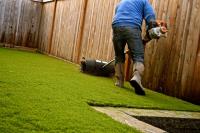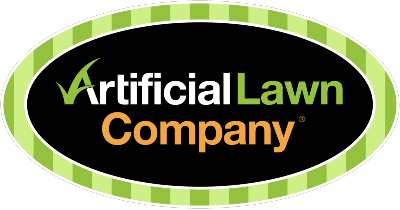 Add My Company
Add My Company
Sign In
Artificial Grass Installation
02-02-2022

If you’re sick of seeding, mowing, and watering your lawn, you might consider the installation of artificial grass in your garden. Here at ALC, we always suggest that you allow our team to install fake grass in your garden at a professional level. Despite this, it’s always good to know about the fake grass installation process so that you’re given a transparent service. Gone are the days of searching “artificial grass installers near me” as ALC are here for all your faux turf installation needs.
Method
In short, the installation method requires you to remove around one or two inches of the existing soil, weeds, stone, etc., and dispose of it. After this, the garden will need to be graded to even levels and falls without lumps or bumps to ensure a completely smooth surface. Next, your lawn area may require edgings to retain the sub-base or to keep the turfed area looking neat. After this, an ALC special granite aggregate blinding layer will need to be supplied, laid, and consolidated.
Then, heavy-duty woven geotextile weed membrane will need to be supplied and laid before the artificial grass is installed in the area. The lawn will need to be secured around the perimeter using six-inch galvanised fixing pins and all joins will be seamed with artificial grass jointing tape and weatherproof polyurethane adhesive. Finally, ALC artificial grass infill sand needs to be spread onto the top of the grass and then brushed using a mechanical rotary brush (power brush).
Levelling the Garden
The process of levelling the area will depend on your garden’s existing surface. For example, if you’re installing synthetic lawn to replace your natural grass, you’ll be left with earth once the grass has been removed. At this point, the earth will need to be settled and compacted to remove large lumps of soil or rocks/stones. The surface needs to be as smooth as possible ahead of the sub-base being installed.
What a lot of people don’t know is that it’s also possible to lay synthetic grass over the top of concrete, slabs, or even decking and balconies. In fact, this can often be easier since existing turf won’t need to be uprooted, and the surface will typically already be smooth and level. That being said, if you are laying onto a hard surface make sure there is a sufficient fall for water to flow off the area. Similarly, we would always recommend an underlay underneath the grass to prolong its lifespan as much as possible. Our 18mm Lawnflex underlay is perfect for laying onto hard and impermeable surfaces.
Sub-Base
One of the most important aspects of the installation process is the sub-base, as this is a huge contributing factor to how long the lawn lasts and the overall finish. Therefore, once your surface has been levelled, a layer of aggregate will need to be installed to create a structured, stable, and level surface for your grass to sit atop; this is called a sub-base.
A sub-base needs to be installed, otherwise, you risk weakness, instability, and poor drainage. When it comes to a suitable sub-base, there are a handful of options, though the most common is crushed granite or limestone. However, at ALC, we use a unique mix of crushed granite aggregate that we have made for us to combine the benefits of both granite and limestone. Our special blend consists of more stone and less dust, meaning that the drainage is impeccable and even better for pets. Despite this, sub-base isn’t a one-size-fits-all solution, although crushed granite sub-base may be the final top layer before the grass, sometimes something more substantial underneath may also be required.
Crushed granite sub-base is best applied on areas that require a build-up, don't require much levelling, have a depth of 25mm – 50mm, or where shingle, paving, or natural turf was initially present, and the ground is fairly well compacted. However, when covering a flowerbed, infilling a fishpond, working in a new-build garden, or working on areas with a depth of more than 50mm, MOT Type 1 sub-base may be better applied. When using MOT Type 1, we’ll always add a 25 mm layer of our crushed granite on top as the final layer is for levelling and draining purposes.
To summarise, your sub-base will be installed to a depth of 25mm – 50mm of the crushed granite and type 1 underneath that if it’s required. This will then be thoroughly compacted before a weed membrane is layered on top to prevent weeds from penetrating through your synthetic turf. Finally, an underlay or shock pad will be laid if our team deems it necessary. At this point, your space will be ready for artificial grass to be applied.
Laying the grass & Hiding Joins
Once the sub-base is laid, compacted, and perfectly levelled with a weed membrane on top, it’s time to install the grass. Make sure the pile of the grass is facing your desired direction, then position the rolls within your grass area and unroll them up to the surrounding edgings. The easiest way to lay the grass is by butting up the first roll of grass against the longest straight edge (if you have one) within the area. This saves on a bit of cutting in and also gets the grass perfectly square across the area.
Once your first piece of grass is cut in and positioned perfectly, the next piece can be added. It’s important to add the next piece and then space the gap for the joint perfectly (sometimes using pins to stop it moving makes this easier) before cutting in the second piece. Once positioned and the second piece of grass is then cut in, you can move on to the joins.
The presence of very visible seams indicates a poorly installed lawn and must be avoided at all costs. This is why we always encourage you to have your lawn installed by our expert team as we’re well equipped with all the tips and tricks to avoid unsightly seams.
In order to achieve our seamless finish, we first ensure that the grain is facing the same way before preparing the edge and positioning. Our lawn pieces tend to have a manufacturing edge strip that we remove before also taking away a couple of stitches. We then cut as close to the stitch as possible to remove the backing, allowing the sections to nicely sit next to each other. During this positioning process, we aim for the gap between the pieces to be the same as the stitch gauge of the grass itself.
Next, we position the jointing tape to bind the lawn sections together; the tape is placed with the smooth green side facing down with the rough white side on top. This is positioned right in between the two pieces of grass, and it can help to pin the tape down. For the adhesive to be applied, the grass is folded back whilst the glue is applied to the tape in a zig-zag motion with a bead along each side Whilst the adhesive is still wet, the grass is folded back over the tape, carefully tucking the two pieces of grass together. This process is much easier with two people as it stops the grass from accidentally folding back quickly and creating a heavy impact on the glue. Then we walk along the seam to ensure the grass is secured.
Sanding, Brushing, and Fixing
The final step, once the grass is laid, is to fix the grass around the perimeter; most commonly, we do this with six-inch galvanized steel pins. These are hammered through the grass and into the sub-base around the whole perimeter roughly every 150mm. If you have pets or an edge that sees greater traffic, more pins will be added. There are multiple ways to fix the grass around the edge, but this is our most common installation method.
Once the grass is secured, our special kiln dried silica sand is then spread onto the top of the grass. For the best possible results, take your time and try to spread the sand as evenly as possible to prevent any lumps. This is spread into the grass to approximately 5-6kg per m2 depending on the pile height of the grass installed.
The final step to finish the installation is giving the grass a good brush with a mechanical rotary brush or power broom. This spreads the sand infill and lifts the pile, creating the perfect lawn for years to come.
Get in Touch with Artificial Lawn Company
If you’re longing for a luscious-looking lawn but can’t stand the maintenance that natural grass entails, please get in touch. Our team will be able to walk you through our artificial grass solutions, as well as our bespoke installation services.
For more information on Artificial Grass Installation talk to Artificial Lawn Company
Enquire Now
List your company on FindTheNeedle.
